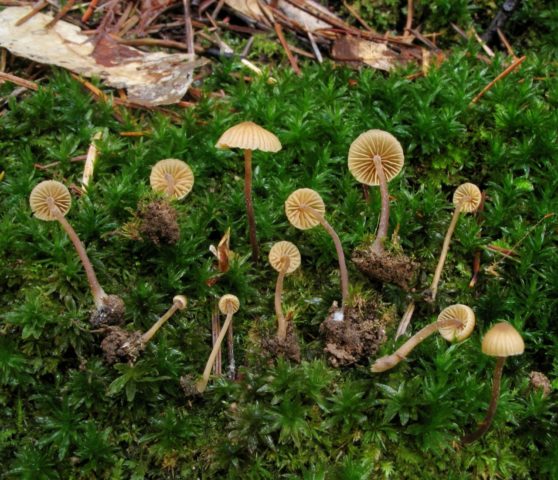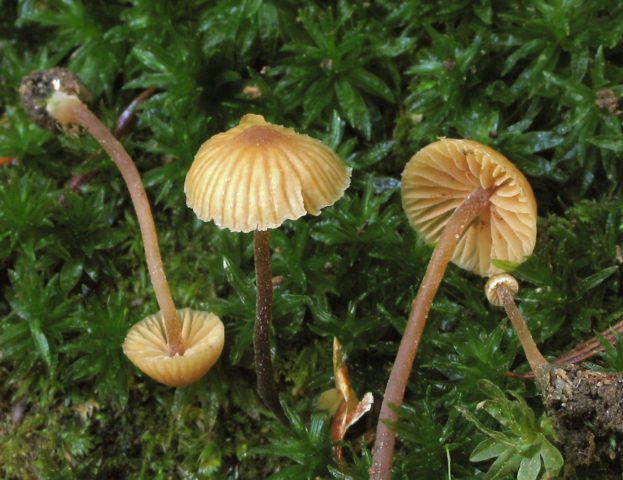Content
Galerina ribbon-like inedible, belongs to the Stropharia family. It belongs to the numerous genus Galerina. In the scientific literature, the species is called Galerina vittiformis. Some mycologists believe that there are several poorly understood forms of this species.

Only the bright coloration of the top and the relatively large size in comparison with the leg make it possible to notice the mushroom
What does a ribbon gallery look like?
Representatives of the ribbon-like inedible genus have very small fruiting bodies:
- total height up to 7-11 cm;
- leg width 1-2 mm;
- head diameter up to 30 mm;
- the cap together with the plates is not thicker than 15 mm.
The initial shape of the cap is conical. Over time, the top opens slightly, acquiring the shape of a miniature bell, or becomes flat and convex, with an elevation in the center. Under the influence of moisture, the pulp swells, accumulating liquid in itself. The skin is bright, yellow, with a honey tint and noticeable brown-brown stripes.
The bottom of the cap is a ribbon-like lamellar variety. In some forms, the plates are often located, in others, on the contrary, rarely, they grow to the stem or are free. On the edge, there are small plates, half the length of those that run along the entire length of the radius. At a young age, the color is cream or light brown. Then the plates darken, become the same color as the skin on top. Spore powder, ocher.
The surface of the leg is brownish or yellow. As the stem grows, starting from the base, it becomes darker - reddish-brown shades appear. The skin of the lower part of young gallerins is pubescent. In the ribbon-like species, the ring is most often absent, while in most other representatives of the genus, the ring is at the top. Thin flesh brittle, yellowish, odorless.

The leg is high and thin in relation to the size of the cap, even, sometimes slightly bent
Where does the ribbon gallery grow
Representatives of the inedible genus grow in wet areas of various forests - coniferous and mixed, in swamps. Galerins are common in the temperate climatic zone of Eurasia and North America.
Mushrooms are saprotrophs that feed on organic debris - on leaf or coniferous litter, dead wood, last year's grass, mosses. Fruiting bodies most often form mycorrhiza with various mosses. Especially large colonies of gallerina are found in places covered with sphagnum. Inedible mushrooms are found from August to the first frost in September or October.
Is it possible to eat a ribbon-like gallery
Since most members of the genus are poisonous, with very dangerous toxins not only for health, but also for human life, ribbon mushrooms are also not collected. It is recommended to bypass such fruiting bodies by the side, both because of the small volume of the pulp, and because of the unpredictable effects on the body. The variety has not yet been fully explored. In addition, there are poisonous representatives of the genus, similar in size and color to the ribbon-like appearance.
Conclusion
Galerina ribbon-like - outwardly unattractive mushroom.And although such fruiting bodies of a yellow-brown color are found in places rich in moisture, quite often, mushroom pickers prefer not to pluck them and, moreover, not to mix them with edible ones, even in a raw state.








